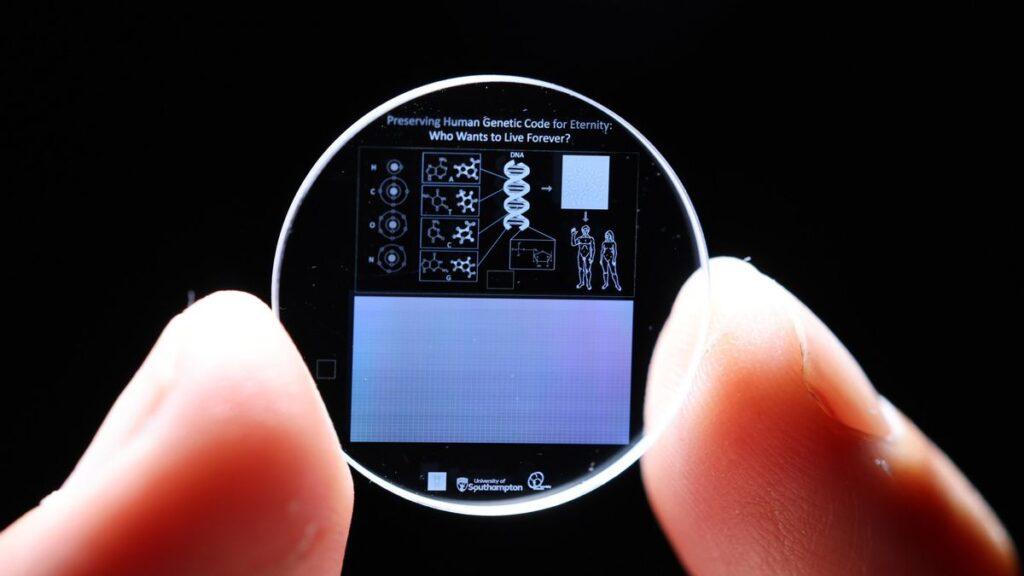- 5D memory crystals keeping a completely human genome for posterity
- Genetic code is preserved in molten quartz
- Unforgettable memory crystals can endure heat, force and cosmic radiation
In 2016, progress was made in the development of data storage when researchers at the University of Southampton successfully developed a 5D memory crystal that was able to store up to 360 terabytes (TB) data with a shelf life of almost 14 billion years.
Unlike conventional data storage formats that are broken down over time, the technology, called “Superman Memory Crystal”, has enormous potential for prolonged data protection, opens new ways in scientific, environmental and historical archiving.
The 5D memory crystal developed by the University of Southampton Optoelectronics Research Center (ORC) is a unique data storage medium that uses five dimensions to code information.
5D memory crystal
The term “5D” refers to the two optical dimensions and three spatial coordinates inscribed in the crystal. With ultra-fast lasers, the team writes data to nanostructured cavities within the silica material, creating a very durable and stable form of memory storage.
A human genome is the complete set of genetic instructions for a human, coded in DNA. It consists of about 3 billion base pairs organized in 23 pairs of chromosomes located in the nucleus of each cell.
Although it is currently not possible to synthetically recreate humans, plants or animals from genetic data, there has been some progress in synthetic biology. Thus, the preservation of genomes using 5D memory crystals could one day play a critical role in reviving extinct species (like us) in the distant future.
The creators of the 5D memory crystal had the future in mind, given that it can be detected long after humans are gone. The crystal is stored in the memory of the archive of the humanity – a unique time capsule located in a salt cave in Hallstatt, Austria. This archive acts as a protection, and preserves human history and knowledge for future generations.
The data inscribed in the crystal is carefully annotated with universal elements such as hydrogen, oxygen, carbon and nitrogen as well as the four DNA bases – Adenine, Cytosine, Guanin and Thymine – which make up the genetic code. In addition, the molecular structure of DNA and the arrangement of genes in chromosomes is depicted, offering clear instructions on how to interpret the genetic information stored within.
However, it is important to note that 5D memory crystals require a highly specialized skill set and advanced equipment to enroll and read the data stored in the crystals so that those who want to restore the human race after an extermination event for more traditional means .
The crystal, made of molten quartz, is one of the most chemical and thermally resistant materials known on the soil and can endure temperatures as high as 1000 ° C, withstand direct impact forces up to 10 tonnes per year. Square centimeters and is not affected by a long time -term exposure to cosmic radiation. The lifetime and storage capacity of the 5D memory crystal achieved it a Guinness World Cup in 2014 to be the most durable data storage material ever created.
“We know from other people’s work that genetic material of simple organisms can be synthesized and used in an existing cell to create a viable living copy in a laboratory,” said Professor Peter Kazansky, the head of the scientific team at the University of Southampton.
“The 5D memory crystal opens the possibilities of other researchers to build an eternal stock of genomic information from which complex organisms such as plants and animals can be restored if science in the future allows… The visual key enrolled in the crystal gives the finder knowledge of, gives the finder knowledge of, What data is stored inside and how it could be used … We do not know if memory crystal technology will ever follow these plaques at a distance, but each disk can be expected with a high degree of confidence to exceed their survival time, ”added Professor Kazansky.



